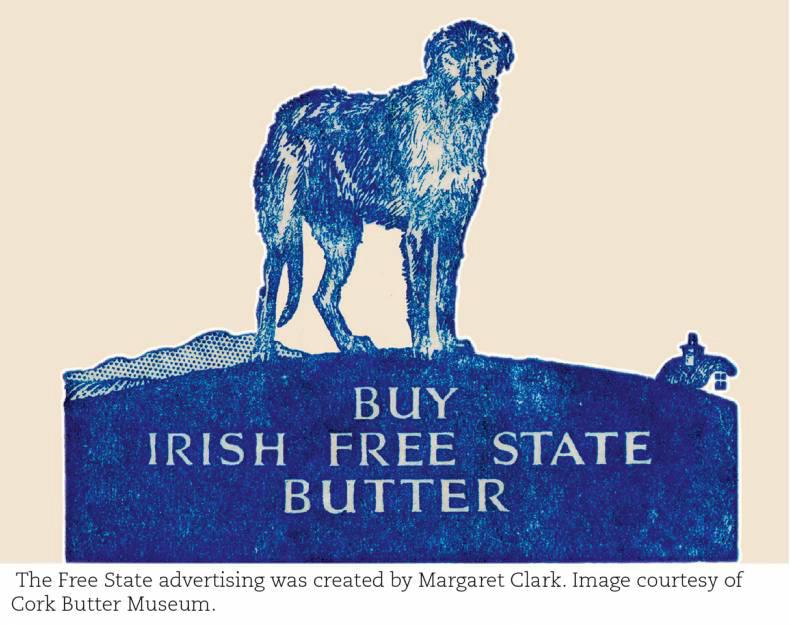Butter was made on a small local scale in Ireland before commercial butter production took hold at the end of the 19th century. There were different methods of producing homemade butter in different parts of Ireland. Butter could be made directly from whole milk, or the cream could be separated off before the butter was made.
At the turn of the 20th century, typically the method used in the north of the country differed from that used in the south. Butter was made directly from a churning process involving whole milk in the north. Whereas in the south only the cream was churned after it had first been separated from the milk.
Aside from the type of production process, butter could also be distinguished by whether or not it was cured. Fresh butter, as the name suggests, was for immediate use and was not cured. However, if butter was to be preserved for use at a later time, then salt would be added in the final stage of production.
Greater amounts of salt were added if the butter was to be required for a longer period. However, the addition of more salt also impacted on the taste.
Making butter
There were three common methods of butter production. A basic method involved agitating the milk in a dish with a stick. This was superseded by a method which involved shaking the milk in a closed vessel. Later still, a method was developed where a plunger was added to the stick. More recent advances in mechanisation would lead to methods that involved the rotation of the vessel itself.
After the churning process the butter was dressed and cured. Dressing was the process of washing any remaining buttermilk out of the butter in order to inhibit spoilage. Curing involved the additional of salt as a preservative.
Churns
A number of different types of churn were used in the 19th and early 20th century. As technology developed, this reduced the amount of time required to make the butter. The plunge churn was the most basic churn and was the most popular with farmers. It was either worked by hand or could be driven by a horse, steam or water as part of a larger-scale production process.
The barrel churn was a churn turned by a handle and it became more popular in late 1800s. It was a more elaborate churn than the plunge churn and produced butter more quickly than the plunge churn.
The box churn was a later development. It differed in shape from the barrel churn, but more importantly it had internal beaters that further speeded up the butter-making process. However, butter made in this way tended not to keep well.
Much of the butter produced in Ireland though the 19th century was sold through the Cork Butter Market, which for a period was the largest butter market in the world.
Did you know? By 1914 there were about 350 dairy co-ops operating around the country
However, over the longer term the butter market failed to adequately enforce quality standards and embrace the movement towards new ways of packaging butter. This meant that butter sold through the market became less popular internationally and this, along with the development of larger scale commercial butter production, led to the demise of the Cork Butter Market in 1924.
Slow to move to commercial-scale production
Ireland was slower than continental Europe to embrace the move from local small-scale butter production towards centralised butter production.
The move towards commercial scale butter production in continental Europe from the mid-1800s, allowed for better quality control and better product standardisation.
Adopting the Danish co-operative model, the Irish Agricultural Organisation Society Ltd. (later renamed the Irish Co-operative Organisation Society Limited – ICOS), was formed in 1894 by Sir Horace Plunkett and his friends. The evolving co-operative movement would in turn influence the development of a number of other institutions that would impact on Irish life in the 20th century.
The seeds of the Credit Union movement in Ireland were sown within ICOS by Fr Tom Finlay. Based on the Raiffeisen system, Ireland’s First Co-operative Agricultural Credit Society was set up in Co Cork in November 1894.
Sir Horace Plunkett himself helped establish the forerunner to today’s Department of Agriculture, Fisheries and Food in Ireland.
The Department of Agriculture and Technical Instruction for Ireland (DATI) was formed in 1899.
With the advice and financial support of ICOS, the Society of the United Irishwomen was formed in 1910. In 1935 the Society of the United Irishwomen changed its name to the Irish Countrywomen’s Association (ICA).
Ireland’s dairy cooperative would later market their output internationally through the Irish Dairy Board (now Ornua), established in 1961, under the internationally famous Kerrygold brand. CL






SHARING OPTIONS